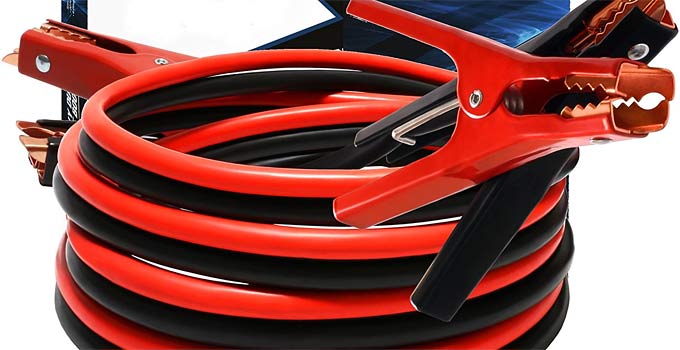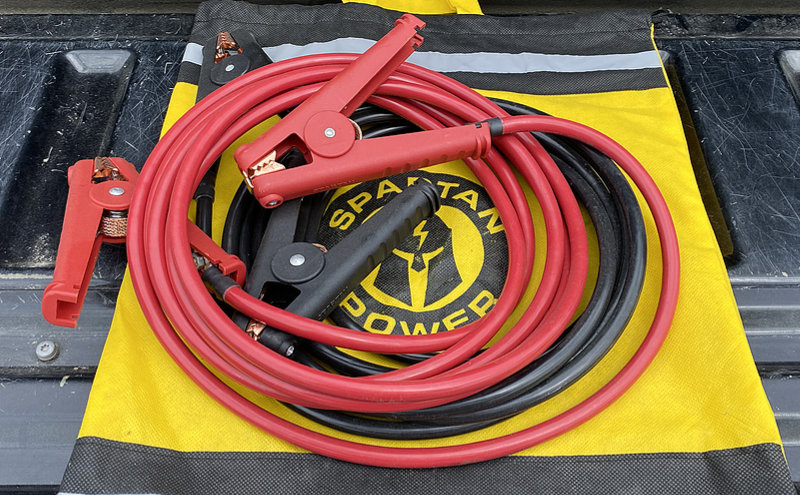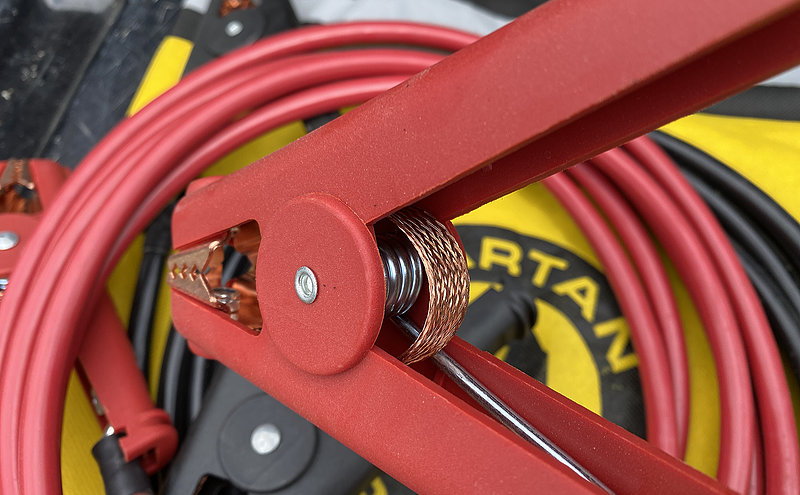Best Jumper Cables ( Size & Gauge Chart )

Here’s a little advice for the best size jumper cable size to keep in your car or truck. I’ve included a general purpose jumper cable gauge chart too.
You do have jumper cables in your vehicle, right?
Did you know that cold temperatures will greatly reduce your car’s battery capacity? That’s one very good reason why it’s a good idea to keep jumper cables for just in case. Another is being a good Samaritan.
As a car battery ages, it will become even more susceptible to poor starting during cold weather. In fact, a car battery can freeze solid in cold weather if it becomes too weak!
If a car battery has a full charge, it will not freeze unless temperatures drop to 76-F below zero. Unless you’re living on Mars (or in North Dakota!), you will likely never face that kind of cold! Your car should start just fine in cold weather if the battery is in good condition and fully charged.
However, on the other hand, if a battery is fully discharged (dead as a door nail), it will freeze solid at 32 degrees F! And a partially charged weakened battery will be susceptible at cold temperatures.
Best Jumper Cable Size (Gauge) ?
The thing with wire size is this:
Size matters.
– The smaller the wire diameter the less power it can handle.
– The larger the wire diameter the more power it can handle.
When starting a car engine it is amazing how much power gets sucked from the battery. In other words, a typical car starter requires a lot of DC Current (Amps) to start the engine.
How much current flow? How many Amps to start a car?
It varies depending on the engine, temperature, battery condition. Generally, a typical car requires about 300 – 500 ‘Cranking Amps’ from the battery while starting.
Diesel engines require more because they have a very high compression ratio. A diesel truck engine may require as much as 1,000 Amps during start up!
Note: The colder it is, more Amps are pulled from the battery. Cold temperatures reduce the electrical charge voltage in a battery and increases the amount of current (Amps) needed to start a vehicle.
Note: Car batteries are rated with Cold Cranking Amps (CCA). It is a rating for the amount of Amps a battery can discharge in 30 seconds at 0 degrees Fahrenheit while maintaining full charge voltage. The higher the CCA the ‘beefier’ the battery.
Wire Gauge For Jumper Cables
Now that we know how many Amps may flow through jumper cables, we can consider the wire gauge size.
It’s all about gauge (and the wire material).
Jumper cable gauge refers to the thickness of the cable’s wiring.
Jumper cable wire is usually made of copper clad aluminum. However pure copper wire is much better (in several ways), but costs more! And it’s heavier.
Note: When looking at wire gauge numbers, the higher the gauge (numerically) the thinner the wire. The lower the gauge number the thicker the wire.
The best jumper cables will be those which are able to flow the most energy from one battery to another. Thicker jumper cables (lower gauge) can transfer more power than thin jumper cables.
The following chart is a general guideline.
The gauge and amps are directly from various jumper cable manufacturers. I have averaged and summarized their data to help figure out what gauge jumper cables you might need.
Sometimes they vary among manufacturers (even for the same gauge). But that is because of wire material differences, and other factors (including Marketing)…

Jumper Cable Gauge Chart
0 (900 – 1000 Amps)
1 (800 Amps)
2 (600 – 800 Amps)
4 (300 – 500 Amps)
6 (200 Amps)
8 (they don’t say)
10 (they don’t say)
10-gauge jumpers may be good for ATV’s, motorcycles, snowmobiles, things like that…
For Most Cars
I would not bother with 6 or 8 for any car. Even though manufacturers may say they’re good for small or mid size cars, I personally like to have some margin! Especially if stuck with a dead battery!
For most cars I recommend 4 gauge jumper cables.
The following set will crank 500 Amps and is 20 feet long:
4 Gauge x 20 Ft 500A Heavy Duty
(view on amzn)
For Trucks
For heavy duty trucks, especially diesel, I recommend 1-gauge jumper cables.
This set of cables will crank 800 Amps and is 25 feet long:
1 Gauge x 25 Ft 800A Heavy Duty
(view on amzn)
What about the best jumper cables?
Okay are you looking for the best jumper cables? Well I can tell you what I bought a number of years ago, and why I bought them…
Pure copper stranded wire, through and through. One thing that can happen to copper clad aluminum (it happened to me before)… They can crack and lose continuity. Then you’re SOL. They also get VERY STIFF when it’s cold. Annoying to wind up. Pure copper stays flexible. Won’t crack. Flows more amps.
However, it is expensive. And the cables are a lot heavier!
This is the brand of jumper cables I bought for my truck (from Spartan, made in USA – actually Reno, NV if I remember correctly),
15 Foot 1/0 AWG Booster Set
(amzn)
My set:

Here’s something really nice about these… BOTH sides of the clamp are powered. Most jumpers are only connected at one side of the clamp grips.

I have republished this article from its original post date (added the guideline gauge chart and pix of my Spartan jumper cables).
Tip: There’s also something called a Jump Pack which has a built in battery designed to jump start a vehicle:
Jump-N-Carry JNC660 1700 Peak Amp 12V Jump Starter
[ Read: Battery Voltage State of Charge Chart ]
